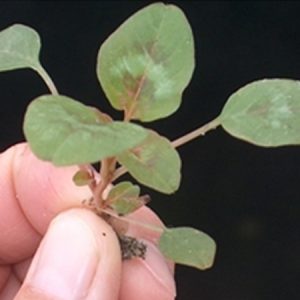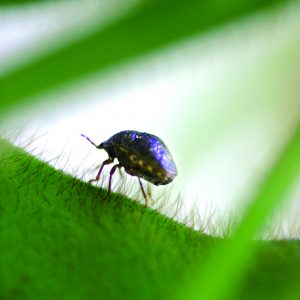Farmers Advised to Scout for Kudzu Bug
(ANNAPOLIS, MARYLAND) – June 1, 2017 – Kudzu bug, an invasive insect, has been identified in nine Maryland counties and growers should be vigilant, according to the Maryland Department of Agriculture.
Kudzu bug, originally from Asia, has been found in Anne Arundel, Calvert, Carroll, Charles, Dorchester, Montgomery, Prince George’s, St. Mary’s, and Talbot counties, the department said.
Soybean growers are advised to scout for the pest, which can reduce yields, but can be controlled with appropriate pesticides.
“Kudzu bugs are invasive species that can have a significant impact on crop yields,” said Agriculture Secretary Joe Bartenfelder. “It is very important that farmers are aware of this insect and plan accordingly. Luckily, the kudzu bug is easily controlled with proper pest management planning.”
Kudzu bug is about the size of a pea and a distinctive olive green with brown speckles. It is broad and flat across the back end. Kudzu bug is a “true bugs” with piercing-sucking mouthparts. According to the department, kudzu bug typically feeds on kudzu vines and then may migrate to soybeans and other types of available beans. Excessive kudzu bug feeding can reduce soybean yields by reducing pods per plant, reducing beans per pod, and/or reducing seed size. In Maryland, the pests have mostly been collected on kudzu, however, some have been found on soybeans in Dorchester County this spring.
To report a sighting or collected sample of kudzu bugs, contact the department’s Plant Protection and Weed Management section at 410-841-5920.
More information on identification, treatment thresholds and approved insecticides may be found here: http://mdkudzubug.org/
Additional material may be found at the United Soybean Board site at http://unitedsoybean.org/article/scouting-key-to-managing-kudzu-bug
The Maryland Soybean Board administers soybean checkoff funds for soybean research, marketing and education programs in the state. It is funded by farmers through an assessment of one-half of one percent of the net market value of soybeans at their first point of sale. One-half of the checkoff funds stay in Maryland for programs; the other half is sent to the United Soybean Board.
In Maryland, farmers grow about a half a million acres of soybeans, producing more than 20 million bushels of beans each year. With a value of $173 million to the state’s economy, soybeans are one of Maryland’s top crops. For more information on the Maryland Soybean Board, visit www.mdsoy.com.
(Photo courtesy of USDA.)
Maryland farmers urged to try new approaches on Palmer Amaranth
Herbicide-resistant weed vexes Maryland, Delaware growers
 (May 19, 2017) – Farmers facing glyphosate- and ALS-resistant Palmer amaranth in their fields will need to take an integrated approach to managing the weeds this season and preventing further spread, says Ben Beale, University of Maryland Extension ag agent.
(May 19, 2017) – Farmers facing glyphosate- and ALS-resistant Palmer amaranth in their fields will need to take an integrated approach to managing the weeds this season and preventing further spread, says Ben Beale, University of Maryland Extension ag agent.
Beale, who works in Southern Maryland, says he saw fields that had extensive infestations of the herbicide-resistant weeds last year in both St. Mary’s and Charles counties. Herbicide-resistant Palmer amaranth also has been confirmed on the Eastern Shore of Maryland and in Delaware.
“Growers with Palmer amaranth should be prepared to rotate crops and chemistries,” Beale says. “They should think ahead about managing the seed bank in their fields, using cultural control methods like tillage or hand-pulling, and throughout the season and into harvest they should do everything they can to prevent the movement of seed from infested to clean fields.”
Beale evaluated 15 different regimens for controlling resistant Palmer amaranth in the summer of 2016 with funding from the Maryland Soybean Board. The board invests soybean checkoff funding to support research, marketing and educational projects.
He found that “any residual herbicide is better than no residual herbicide.” Residual products that worked well included products with Flumioxazin (Valor) including premixes of Fierce or Fierce XLT, and products with sulfentrazone (Authority) including premixes such as Broadaxe, Authority Elite, and Authority MTZ.
However, Beale says, none of the residual products provided consistently clean fields throughout the season. “This weed is a challenge,” he says. “Growers who have it need to address it now, and those who don’t need to do everything to prevent it from taking hold in their fields. That includes scouting hedgerows and insisting that combines are clean, with infested fields ideally being harvested last.”
The Maryland Soybean Board administers soybean checkoff funds for soybean research, marketing and education programs in the state. It is funded by farmers through an assessment of one-half of one percent of the net market value of soybeans at their first point of sale. One-half of the checkoff funds stay in Maryland for programs; the other half is sent to the United Soybean Board.
In Maryland, farmers grow about a half a million acres of soybeans, producing more than 20 million bushels of beans each year. With a value of $173 million to the state’s economy, soybeans are one of Maryland’s top crops. For more information on the Maryland Soybean Board, visit www.mdsoy.com.
# # #
For More Information:
Sandra Davis, Executive Director, Maryland Soybean Board
Office: 410.742.9500
sdavis26@verizon.net
Maryland Farmers: On Ag Day, commitment to land, water shines
By Travis Hutchison, Chairman, Maryland Soybean Board
(March 17, 2017) – As we recognize 2017 National Ag Day on March 21 and Earth Day next month, we begin another year in the fields. I’ve been thinking about the ways things have changed on our family farm from my father’s generation to mine, to protect the environment for my generation and the next.
At this time of year when I was a kid, my dad did a lot of moldboard plowing to get the ground in shape for planting. This meant the plow dug about 8 inches deep and, as it sliced through the soil, turned the ground completely over. We had been taught that this method would lead to better yields and better weed control.
Over the years, we learned the opposite — that minimum tillage and no-till could give us as good or better results. By reducing tillage, we saved on labor, reduced emissions, and, most importantly for the Bay and our future as farmers, minimized soil erosion.
And that’s not the only change. In the past, we applied most of our fertilizer at one time. Now we split up our fertilizer applications and “spoon feed” the crops. We’re not putting on more fertilizer, just applying it as the crop needs it. We use a pre-sidedress nitrate test or “PSNT,” which samples the soil for its levels of nitrogen (a key plant food) to determine how much the plant needs to finish out the crop.
Because my family believes strongly in protecting our land and water resources, we’ve followed a nutrient management plan on our farm long before the state of Maryland required all state farmers to do so. People probably don’t realize the work farmers put in on these plans – testing their soil and poultry manure for nutrients and balancing those against crop needs for each field and then maintaining the records to prove you followed the plan.
Like most Maryland farmers I know, we constantly evaluate new ideas, technology and practices to see if they work on our farm.
We plant about three-quarters of our acres in cover crops each fall, using cold-hardy plants to protect the soil from erosion, tap nutrients that may have been left behind by a previous crop, and provide organic matter to improve the soil after the cover dies. It’s not only the organic farms that use cover crops or care about improving soil. We put a lot of effort into our soil.
Building our soil means adding organic matter, so we buy up to 4,000 tons of chicken manure each year. Yes, you read that right: we BUY manure! It’s a great fertilizer and soil enhancer. Our ground has low phosphorus so we use as much as we can. We also invested in a manure shed that lets us receive manure year-round and keep it covered, so rainfall doesn’t wash away nutrients.
And, we invested in Green Seeker Technology. This is a sensor that reads the chlorophyll (or “green”) of plant leaves to determine if they need more nitrogen, then customizes the fertilizer application. That’s great for plant health and yield, and great for us as farmers.
Our family knows that by using this technology we are fertilizing the right amount at the right time for the crop. Although it’s an expensive investment, it will pay off over time, and we know it’s the right choice for our land, our business and our family.
Recently, on three of our farms, we installed ditch bioreactors. They funnel the water from the ditch into a structure with wood chips. The chips remove nitrogen from the water, allowing the water to exit the bioreactor with up to 90 percent nitrogen reduction.
These are just some of the practices that my family and I have adopted on our farmland. In total, my family has a list showing more than 40 practices that Maryland farmers have adapted to protect the environment. That’s why I’m proud to say farmers are the “original environmentalists.”
more than 40 practices that Maryland farmers have adapted to protect the environment. That’s why I’m proud to say farmers are the “original environmentalists.”
On behalf of my fellow Maryland farmers, I invite the community to learn more by visiting a few farms (you’ll find many at www.marylandsbest.net) and talking with Maryland farmers about the many ways they protect our natural resources.
Hutchison farms with his father, two uncles and cousins at Hutchison Brothers farm in Cordova, Md. He is chairman of the Maryland Soybean Board.
Maryland’s Heilman and Miller to attend 2017 Soybean Leadership College
(SALISBURY, MARYLAND) – Maryland farmers Amanda Heilman and Wes Miller will attend the 2017 Soybean Leadership College Jan. 10-12 in St. Louis, Mo.
 Heilman, of Worcester County, Md., is a seed sales representative for Pioneer Brand Products at Perdue Agribusiness. Miller, of Cecil County, is herdsman at Chesapeake Gold Farms, his family dairy farm which currently milks 250 cows and farms 1,500 acres.
Heilman, of Worcester County, Md., is a seed sales representative for Pioneer Brand Products at Perdue Agribusiness. Miller, of Cecil County, is herdsman at Chesapeake Gold Farms, his family dairy farm which currently milks 250 cows and farms 1,500 acres.
The Maryland Soybean Board is sponsoring their trip. In Maryland, farmers grow about a half a million acres of soybeans, producing more than 20 million bushels of beans each year. With a value of $173 million to the state’s economy, soybeans are one of Maryland’s top crops.
Heilman graduated from University of Maryland College Park with a double major in Animal Science and Agricultural Science and Technology. Since college, she has worked on Delmarva as a crop consultant with focuses on nutrient management planning and conservation planning. A 2015 graduate of LEAD Maryland, Heilman serves on the board of the Worcester County Farm Bureau. She is a volunteer for CommonGround, a program that connects farm spokewomen with their non-farming peers to answer questions about farming and food production. Heilman blogs and posts under the handle “Delmarva Crop Queen.”
Miller manages the daily operations of the Chesapeake Gold Farms dairy and its employees. A 2012 graduate from the Pennsylvania State University with a bachelor’s degree in Animal Science, in 2016, Miller was awarded the first Outstanding Young Farmer of the Year award from Gov. Larry Hogan and the Maryland Department of Agriculture. Miller also is active in Farm Bureau’s Young Farmers and Ranchers program and serves on the Cecil County Farm Bureau board.
Soybean Leadership College, coordinated by the American Soybean Association, provides current and future agricultural industry leaders with training to effectively promote the soybean industry, communicate key agricultural messages and work to expand U.S. soybean market opportunities domestically and internationally.
The program also fosters networking between growers from across the country, encouraging collaboration, which in turn increases the effectiveness of soybean growers at the local, regional and national level.
The Maryland Soybean Board administers soybean checkoff funds for soybean research, marketing and education programs in the state. It is funded by farmers through an assessment of one-half of one percent of the net market value of soybeans at their first point of sale. One-half of the checkoff funds stay in Maryland for programs; the other half is sent to the United Soybean Board.
For more information on the Maryland Soybean Board, visit www.mdsoy.com.
# # #
For More Information:
Sandra Davis, Executive Director, Maryland Soybean Board
Office: 410.742.9500
sdavis26@verizon.net
Archives
No Results Found
The page you requested could not be found. Try refining your search, or use the navigation above to locate the post.

